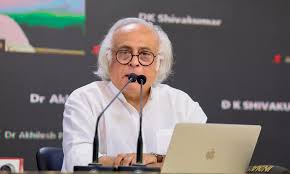‘Intellectually dishonest’: Congress slams govt assertion on India being among ‘most equal’ countries

The Congress party has strongly criticized the government’s recent claim that India is one of the most equal countries in the world. The opposition described the statement as “intellectually dishonest” and said it misrepresents the actual economic conditions in the country.
Earlier this week, the Ministry of Finance presented data showing improvements in income distribution. The government highlighted welfare schemes and pointed to metrics like the Gini coefficient to support its claim. It argued that schemes like PM-KISAN and free foodgrain distribution have reduced poverty and improved equality.
Congress Pushes Back with Strong Words
Congress leader Jairam Ramesh quickly responded. He said the government’s claim ignored the “deep and growing inequalities” in Indian society. According to him, the ruling party is trying to paint a false picture of economic progress.
“The Modi government’s narrative is not just misleading—it’s dishonest,” Ramesh said. “People are facing joblessness, low wages, and price rises. How can we be called equal?”
What Does the Government Claim?
The Finance Ministry’s report praised the success of several social welfare programs. It cited reduced poverty levels, wider access to basic services, and improved financial inclusion as signs of progress.
Officials argued that the number of people living in poverty has dropped. They credited this to direct benefit transfers, rural electrification, and improved infrastructure. According to them, India is moving toward inclusive growth, especially in rural areas.
They also mentioned India’s relatively stable Gini coefficient, which they believe shows reduced income inequality.
Congress Accuses Government of Cherry-Picking Data
Congress leaders have accused the government of only highlighting positive numbers while ignoring ground realities. Party spokesperson Supriya Shrinate said the claims lacked context and were misleading.
“Welfare schemes do help, but they don’t erase the fact that the richest 1% owns over 40% of national wealth,” Shrinate said. “People are struggling to find decent jobs. Farmers are still dying by suicide. That is the real India.”
She also pointed to recent reports that show wealth is increasingly concentrated among a small elite, while the poor remain trapped in a cycle of poverty.
Expert Opinions: What Do Economists Say?
Several economists have expressed doubts about the government’s equality claim. They say access to basic services has improved, but income and wealth gaps remain wide.
Dr. Jayati Ghosh, a development economist, explained the issue clearly. “Giving people a gas cylinder or a ration card doesn’t mean wealth is fairly distributed. The rich continue to grow richer.”
Another expert, Prabhat Patnaik, said the government’s claim ignores structural problems. “Informal workers, small farmers, and low-income earners have seen little change in their economic status,” he noted.
Inequality in Numbers
Various reports offer evidence that supports Congress’s stance. The World Inequality Report 2022 stated:
- The top 1% of Indians hold more than 40% of total wealth
- The bottom 50% owns just 3%
- Wealth inequality has risen sharply since the early 2000s
The Oxfam India Inequality Report also shows how the pandemic deepened existing gaps. While India added more billionaires during COVID-19, millions lost jobs or fell into poverty.
According to Credit Suisse, India’s richest people continue to gain more wealth while the poor see little improvement.
Rural vs Urban India: The Divide Widens
In cities, signs of development are easy to see. High-rise apartments, shopping malls, and smart infrastructure projects reflect a growing middle and upper class. But not far from these zones of prosperity, millions still live in slums or cramped housing with poor access to clean water and healthcare.
In rural areas, the situation is even more worrying. Many villages face poor connectivity, few job opportunities, and limited healthcare. Farmer distress remains a serious concern, and rural youth often migrate to cities in search of work.
Despite government claims of progress, the divide between urban and rural India continues to grow.
Government Defends Its Position
In response to criticism, Finance Ministry officials have defended their assessment. They insist their claims are based on verified data. According to them, social security programs have reached more people than ever before.
A senior official said, “We’re not denying challenges. But we have brought millions out of extreme poverty. We’ve expanded public services in health, finance, and energy.”
They also highlighted programs like Jan Dhan Yojana, Ayushman Bharat, and Digital India as examples of inclusive growth.
Opposition Says Ground Reality Tells a Different Story
Congress and other opposition leaders argue that the reality on the ground tells a different story. Rising prices, job losses, and poor public services in many areas show that inequality is still a pressing issue.
They believe the government is trying to build a positive narrative ahead of the elections, rather than tackling the real problems. “Numbers can be made to look good,” Jairam Ramesh said, “but people can feel the difference in their lives.”
Conclusion: A Claim Under Scrutiny
The government’s claim that India is among the world’s most equal nations has sparked strong political and public debate. While it highlights certain gains, many believe it oversimplifies a complex issue.
Experts, opposition leaders, and several reports suggest that India’s economic inequality remains a major challenge. Welfare schemes may have helped ease some burdens, but the gap between the rich and the poor continues to grow.
Calling India a “most equal country” may sound good in reports, but for many Indians, that title feels far from reality.






